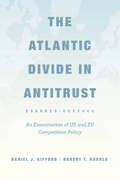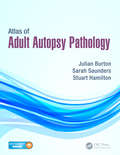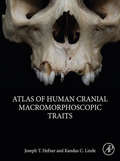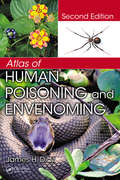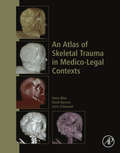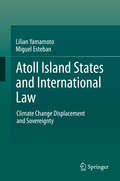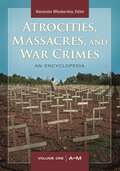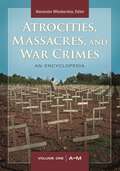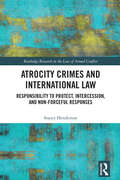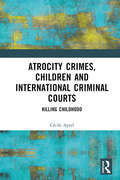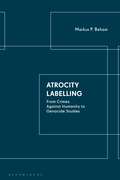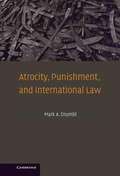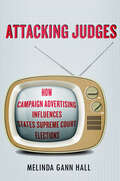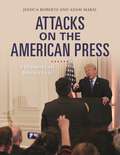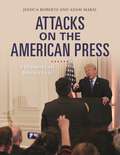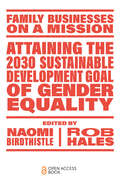- Table View
- List View
The Atlantic Divide in Antitrust: An Examination of US and EU Competition Policy
by Daniel J. Gifford Robert T. KudrleHow is it that two broadly similar systems of competition law have reached different results across a number of significant antitrust issues? While the United States and the European Union share a commitment to maintaining competition in the marketplace and employ similar concepts and legal language in making antitrust decisions, differences in social values, political institutions, and legal precedent have inhibited close convergence. With The Atlantic Divide in Antitrust, Daniel J. Gifford and Robert T. Kudrle explore many of the main contested areas of contemporary antitrust, including mergers, price discrimination, predatory pricing, and intellectual property. After identifying how prevailing analyses differ across these areas, they then examine the policy ramifications. Several themes run throughout the book, including differences in the amount of discretion firms have in dealing with purchasers, the weight given to the welfare of various market participants, and whether competition tends to be viewed as an efficiency-generating process or as rivalry. The authors conclude with forecasts and suggestions for how greater compatibility might ultimately be attained.
The Atlantic Divide in Antitrust: An Examination of US and EU Competition Policy
by Daniel J. Gifford Robert T. KudrleHow is it that two broadly similar systems of competition law have reached different results across a number of significant antitrust issues? While the United States and the European Union share a commitment to maintaining competition in the marketplace and employ similar concepts and legal language in making antitrust decisions, differences in social values, political institutions, and legal precedent have inhibited close convergence. With The Atlantic Divide in Antitrust, Daniel J. Gifford and Robert T. Kudrle explore many of the main contested areas of contemporary antitrust, including mergers, price discrimination, predatory pricing, and intellectual property. After identifying how prevailing analyses differ across these areas, they then examine the policy ramifications. Several themes run throughout the book, including differences in the amount of discretion firms have in dealing with purchasers, the weight given to the welfare of various market participants, and whether competition tends to be viewed as an efficiency-generating process or as rivalry. The authors conclude with forecasts and suggestions for how greater compatibility might ultimately be attained.
The Atlantic Divide in Antitrust: An Examination of US and EU Competition Policy
by Daniel J. Gifford Robert T. KudrleHow is it that two broadly similar systems of competition law have reached different results across a number of significant antitrust issues? While the United States and the European Union share a commitment to maintaining competition in the marketplace and employ similar concepts and legal language in making antitrust decisions, differences in social values, political institutions, and legal precedent have inhibited close convergence. With The Atlantic Divide in Antitrust, Daniel J. Gifford and Robert T. Kudrle explore many of the main contested areas of contemporary antitrust, including mergers, price discrimination, predatory pricing, and intellectual property. After identifying how prevailing analyses differ across these areas, they then examine the policy ramifications. Several themes run throughout the book, including differences in the amount of discretion firms have in dealing with purchasers, the weight given to the welfare of various market participants, and whether competition tends to be viewed as an efficiency-generating process or as rivalry. The authors conclude with forecasts and suggestions for how greater compatibility might ultimately be attained.
Atlas of Adult Autopsy Pathology
by Julian Burton Sarah Saunders Stuart HamiltonThe Atlas of Adult Autopsy Pathology is a full-color atlas for those performing, or learning to perform, adult autopsies. It is arranged by organ systems and also includes chapters on external examination findings, the effect of decomposition, and histopathological findings, as well as procedures and devices one may encounter during autopsy.The boo
Atlas of Human Cranial Macromorphoscopic Traits
by Joseph T. Hefner Kandus C. LindeAtlas of Human Cranial Macromorphoscopic Traits synthesizes macromorphoscopic traits and their analysis in an accessible manner, providing detailed descriptions and examples of the various character state manifestations intended for use in classrooms, laboratories, and in the field. The volume begins with an outline of the macromorphoscopic dataset, its history, recent modifications to the historical approach, and recent technological and analytical advances. Additional sections cover Nomenclature, Gross Anatomy, Function, Methodology, Line Drawings, Detailed Definitions, Multiple High-resolution Photographs, and Population Variation Data from the Macromorphoscopic Databank (MaMD). The volume concludes with a chapter outlining the statistical analysis of macromorphoscopic data and a summary of the computer programs and reference databases available to forensic anthropologists for the analysis of these data.Provides detailed descriptions, illustrations and high-resolution images of various character state manifestations of seventeen macromorphoscopic traitsApplies to both forensic and bioarcheological researchWritten by the foremost expert on macromorphoscopic trait analysis and estimation of ancestry in forensic anthropology
Atlas of Human Poisoning and Envenoming
by James H. DiazClinicians undergoing competency testing, certification, and periodic recertification are frequently faced with computer-based exams designed to evaluate clinical acumen and judgment. Test questions often include an image or radiograph followed by a vignette of the clinical encounter and a series of questions. Designed to better prepare practitione
An Atlas of Skeletal Trauma in Medico-Legal Contexts
by Soren Blau David Ranson Chris O'DonnellPost-mortem computed tomography (PMCT) is increasingly used in forensic pathology practice in many jurisdictions. Such imaging has expanded the capacity to evaluate skeletal trauma improving the visualisation, documentation and presentation of forensic findings. Typically when deceased persons are located and exhibit evidence of trauma, forensic pathologist, anthropologists and radiologists base their interpretations of the mechanism of trauma on their experience and understanding of the biomechanics of fractures as well as recognisable patterns of injury. In order to augment this process, An Atlas of Forensic Skeletal Trauma presents a range of de-identified adult and child skeletal trauma cases that occur in medico-legal contexts where the cause of death and mechanism of trauma are recorded. An Atlas of Forensic Skeletal Trauma includes comprehensive photographs and PMCT images as well as descriptive text.Presents a valuable guide to the interpretation of skeletal trauma for practitioners and students of forensic anthropology, pathology and radiologyProvides coverage of skeletal trauma cases resulting from high and low velocity projectiles, low energy blunt force (e.g., assaults involving various implements, hangings, strangulations, falls), high energy blunt force (e.g., motor vehicle and aviation incidents), and moreIncludes case studies with written and visual descriptions, discussions and up-to-date literature review
Atoll Island States and International Law: Climate Change Displacement and Sovereignty
by Lilian Yamamoto Miguel EstebanAtoll Island States exist on top of what is perceived to be one of the planet's most vulnerable ecosystems: atolls. It has been predicted that an increase in the pace of sea level rise brought about by increasing greenhouse gas concentrations in the atmosphere will cause them to disappear, forcing their inhabitants to migrate. The present book represents a multidisciplinary legal and engineering perspective on this problem, challenging some common misconceptions regarding atolls and their vulnerability to sea-level rise. Coral islands have survived past changes in sea levels, and it is the survival of coral reefs what will be crucial for their continued existence. These islands are important for their inhabitants as they represent not only their ancestral agricultural lands and heritage, but also a source of revenue through the exploitation of the maritime areas associated with them. However, even if faced with extreme climate change, it could theoretically be possible for the richer Atoll Island States to engineer ways to prevent their main islands from disappearing, though sadly not all will have the required financial resources to do so. As islands become progressively uninhabitable their residents will be forced to settle in foreign lands, and could become stateless if the Atoll Island State ceases to be recognized as a sovereign country. However, rather than tackling this problem by entering into lengthy negotiations over new treaties, more practical solutions, encompassing bilateral negotiations or the possibility of acquiring small new territories, should be explored. This would make it possible for Atoll Island States in the future to keep some sort of international sovereign personality, which could benefit the descendents of its present day inhabitants.
Atrocities, Massacres, and War Crimes [2 volumes] [2 volumes]: 2 volumes [2 volumes]
by Alexander MikaberidzeBoth concise and wide-ranging, this encyclopedia covers massacres, atrocities, war crimes, and genocides, including acts of inhumanity on all continents; and serves as a reminder that lest we forget, history will repeat itself.The 400-plus entries in Atrocities, Massacres, and War Crimes: An Encyclopedia provide accessible and concise information on the difficult subject of abject human violence committed on all continents. The entries in this two-volume work describe atrocities, massacres, and war crimes committed in the 20th century, thereby documenting how human beings have repeatedly proven their capability to commit horrific acts of inhumanity even in relatively recent times and within the modern era. The encyclopedia covers countries, treaties, and terms; profiles individuals who had been formally indicted for war crimes as well as those who have committed mass atrocities and gone unpunished; and addresses human rights violations, crimes against humanity, and crimes against peace.
Atrocities, Massacres, and War Crimes [2 volumes] [2 volumes]: 2 volumes [2 volumes]
Both concise and wide-ranging, this encyclopedia covers massacres, atrocities, war crimes, and genocides, including acts of inhumanity on all continents; and serves as a reminder that lest we forget, history will repeat itself.The 400-plus entries in Atrocities, Massacres, and War Crimes: An Encyclopedia provide accessible and concise information on the difficult subject of abject human violence committed on all continents. The entries in this two-volume work describe atrocities, massacres, and war crimes committed in the 20th century, thereby documenting how human beings have repeatedly proven their capability to commit horrific acts of inhumanity even in relatively recent times and within the modern era. The encyclopedia covers countries, treaties, and terms; profiles individuals who had been formally indicted for war crimes as well as those who have committed mass atrocities and gone unpunished; and addresses human rights violations, crimes against humanity, and crimes against peace.
Atrocity Crimes and International Law: Responsibility to Protect, Intercession, and Non-Forceful Responses (Routledge Research in the Law of Armed Conflict)
by Stacey HendersonDespite repeated declarations of ‘never again’ in response to the commission of atrocities, civilians have continued to be targeted by their leaders and opposition groups. The international law principles of sovereignty and non-intervention, when taken at their highest, require States to stand idle and not intervene in another State regardless of what atrocities may be occurring there. This traditional legal view is being challenged by an emerging practice of States choosing to respond in non-forceful ways, inspired by the concept of the Responsibility to Protect (R2P). Drawing on R2P, this book introduces and develops an original conceptual tool –intercession –to capture and explain this change in State practice and the impact of R2P on the development of international law. Through a close examination of State practice, the work explores whether there has been an expansion in the permissible measures and situations in which States can intervene, without using force, in response to atrocity crimes occurring in other States. This book concludes that the development of the secondary duty on the international community under R2P provides the greatest opportunity to progress the R2P framework in a meaningful way, which will have a significant impact on the protection of populations from atrocity crimes. The book will be essential reading for students, researchers and policymakers working in the areas of international law, international relations, humanitarian law, and peace and security studies.
Atrocity Crimes and International Law: Responsibility to Protect, Intercession, and Non-Forceful Responses (Routledge Research in the Law of Armed Conflict)
by Stacey HendersonDespite repeated declarations of ‘never again’ in response to the commission of atrocities, civilians have continued to be targeted by their leaders and opposition groups. The international law principles of sovereignty and non-intervention, when taken at their highest, require States to stand idle and not intervene in another State regardless of what atrocities may be occurring there. This traditional legal view is being challenged by an emerging practice of States choosing to respond in non-forceful ways, inspired by the concept of the Responsibility to Protect (R2P). Drawing on R2P, this book introduces and develops an original conceptual tool –intercession –to capture and explain this change in State practice and the impact of R2P on the development of international law. Through a close examination of State practice, the work explores whether there has been an expansion in the permissible measures and situations in which States can intervene, without using force, in response to atrocity crimes occurring in other States. This book concludes that the development of the secondary duty on the international community under R2P provides the greatest opportunity to progress the R2P framework in a meaningful way, which will have a significant impact on the protection of populations from atrocity crimes. The book will be essential reading for students, researchers and policymakers working in the areas of international law, international relations, humanitarian law, and peace and security studies.
Atrocity Crimes, Children and International Criminal Courts: Killing Childhood
by Cécile AptelThis book shows how international criminal courts have paid only limited and inconsistent attention to atrocity crimes affecting children. It elucidates the many structural, legal, financial and even attitudinal obstacles, often overlapping, that have contributed to the international courts’ focus on the experience of adults, rendering children almost invisible. It reviews whether and how different international and hybrid criminal jurisdictions have considered international crimes committed against or by children. The book also considers how international criminal justice can help contribute to the recognition of the specific impact that international crimes have on children, whether as victims or as participants, and strengthen their protection. Finally, it proposes an agenda to improve this situation, making specific recommendations encompassing the urgent need to further elaborate child-friendly procedures. It also calls for international investigative and prosecutorial strategies to be less adult-centric and broaden the scope of crimes against children beyond the focus on child-soldiers. This book is an invaluable resource for academics, researchers and fieldworkers in the areas of international criminal law, international human rights law/child rights, international humanitarian law, child protection and transitional justice.
Atrocity Crimes, Children and International Criminal Courts: Killing Childhood
by Cécile AptelThis book shows how international criminal courts have paid only limited and inconsistent attention to atrocity crimes affecting children. It elucidates the many structural, legal, financial and even attitudinal obstacles, often overlapping, that have contributed to the international courts’ focus on the experience of adults, rendering children almost invisible. It reviews whether and how different international and hybrid criminal jurisdictions have considered international crimes committed against or by children. The book also considers how international criminal justice can help contribute to the recognition of the specific impact that international crimes have on children, whether as victims or as participants, and strengthen their protection. Finally, it proposes an agenda to improve this situation, making specific recommendations encompassing the urgent need to further elaborate child-friendly procedures. It also calls for international investigative and prosecutorial strategies to be less adult-centric and broaden the scope of crimes against children beyond the focus on child-soldiers. This book is an invaluable resource for academics, researchers and fieldworkers in the areas of international criminal law, international human rights law/child rights, international humanitarian law, child protection and transitional justice.
Atrocity Labelling: From Crimes Against Humanity to Genocide Studies
by Markus P. BehamAtrocity. Genocide. War crime. Crime Against Humanity. Such atrocity labels have been popularized among international lawmakers but with little insight offered into how and when these terms are applied and to what effect. What constitutes an event to be termed a genocide or war crime and what role does this play in the application of legal proceedings?Markus P. Beham, through an interdisciplinary and comparative approach, unpicks these terms to uncover their historical genesis and their implications for international criminal law initiatives concerned with atrocity. The book uniquely compares four specific case studies: Belgian colonial exploitation of the Congo, atrocities committed against the Herero and Nama in German South-West Africa, the Armenian genocide and the man-made Ukrainian famine of the 1930s. Encompassing international law, legal history, and discourse analysis, the concept of 'atrocity labelling' is used to capture the meaning underlying the work of international lawyers and prosecutors, historians and sociologists, agenda setters and policy makers.
Atrocity Labelling: From Crimes Against Humanity to Genocide Studies
by Markus P. BehamAtrocity. Genocide. War crime. Crime Against Humanity. Such atrocity labels have been popularized among international lawmakers but with little insight offered into how and when these terms are applied and to what effect. What constitutes an event to be termed a genocide or war crime and what role does this play in the application of legal proceedings?Markus P. Beham, through an interdisciplinary and comparative approach, unpicks these terms to uncover their historical genesis and their implications for international criminal law initiatives concerned with atrocity. The book uniquely compares four specific case studies: Belgian colonial exploitation of the Congo, atrocities committed against the Herero and Nama in German South-West Africa, the Armenian genocide and the man-made Ukrainian famine of the 1930s. Encompassing international law, legal history, and discourse analysis, the concept of 'atrocity labelling' is used to capture the meaning underlying the work of international lawyers and prosecutors, historians and sociologists, agenda setters and policy makers.
Atrocity, Punishment, And International Law (PDF)
by Mark A. DrumblThis book argues that accountability for extraordinary atrocity crimes should not uncritically adopt the methods and assumptions of ordinary liberal criminal law. Criminal punishment designed for common criminals is a response to mass atrocity and a device to promote justice in its aftermath. This book comes to this conclusion after reviewing the sentencing practices of international, national, and local courts and tribunals that punish atrocity perpetrators. Sentencing practices of these institutions fail to attain the goals that international criminal law ascribes to punishment, in particular retribution and deterrence. Fresh thinking is necessary to confront the collective nature of mass atrocity and the disturbing reality that individual membership in group-based killings is often not maladaptive or deviant behavior but, rather, adaptive or conformist behavior. This book turns to a modern, and adventurously pluralist, application of classical notions of cosmopolitanism to advance the frame of international criminal law to a broader construction of atrocity law and towards an interdisciplinary, contextual, and multicultural conception of justice.
Atrocity Speech Law: Foundation, Fragmentation, Fruition
by Gregory S. GordonThe law governing the relationship between speech and core international crimes a key component in atrocity prevention is broken. Incitement to genocide has not been adequately defined. The law on hate speech as persecution is split between the International Criminal Tribunal for Rwanda (ICTR) and the International Criminal Tribunal for the former Yugoslavia (ICTY). Instigation is confused with incitement and ordering's scope is too circumscribed. At the same time, each of these modalities does not function properly in relation to the others, yielding a misshapen body of law riddled with gaps. Existing scholarship has suggested discrete fixes to individual parts, but no work has stepped back and considered holistic solutions. This book does. To understand how the law became so fragmented, it returns to its roots to explain how it was formulated. From there, it proposes a set of nostrums to deal with the individual deficiencies. Its analysis then culminates in a more comprehensive proposal: a Unified Liability Theory, which would systematically link the core crimes of genocide, crimes against humanity, and war crimes with the four illicit speech modalities. The latter would be placed in one statutory provision criminalizing the following types of speech: (1) incitement (speech seeking but not resulting in atrocity); (2) speech abetting (non-catalytic speech synchronous with atrocity commission); (3) instigation (speech seeking and resulting in atrocity); and (4) ordering (instigation/incitement within a superior-subordinate relationship). Apart from its fragmentation, this body of law lacks a proper name as Incitement Law or International Hate Speech Law, labels often used, fail to capture its breadth or relationship to mass violence. So this book proposes a new and fitting appellation: atrocity speech law.
Atrocity Speech Law: Foundation, Fragmentation, Fruition
by Gregory S. GordonThe law governing the relationship between speech and core international crimes a key component in atrocity prevention is broken. Incitement to genocide has not been adequately defined. The law on hate speech as persecution is split between the International Criminal Tribunal for Rwanda (ICTR) and the International Criminal Tribunal for the former Yugoslavia (ICTY). Instigation is confused with incitement and ordering's scope is too circumscribed. At the same time, each of these modalities does not function properly in relation to the others, yielding a misshapen body of law riddled with gaps. Existing scholarship has suggested discrete fixes to individual parts, but no work has stepped back and considered holistic solutions. This book does. To understand how the law became so fragmented, it returns to its roots to explain how it was formulated. From there, it proposes a set of nostrums to deal with the individual deficiencies. Its analysis then culminates in a more comprehensive proposal: a Unified Liability Theory, which would systematically link the core crimes of genocide, crimes against humanity, and war crimes with the four illicit speech modalities. The latter would be placed in one statutory provision criminalizing the following types of speech: (1) incitement (speech seeking but not resulting in atrocity); (2) speech abetting (non-catalytic speech synchronous with atrocity commission); (3) instigation (speech seeking and resulting in atrocity); and (4) ordering (instigation/incitement within a superior-subordinate relationship). Apart from its fragmentation, this body of law lacks a proper name as Incitement Law or International Hate Speech Law, labels often used, fail to capture its breadth or relationship to mass violence. So this book proposes a new and fitting appellation: atrocity speech law.
Attacking Judges: How Campaign Advertising Influences State Supreme Court Elections (Stanford Studies in Law and Politics #14)
by Melinda Gann HallNasty, below-the-belt campaigns, mudslinging, and character attacks. These tactics have become part and parcel of today's election politics in America, and judicial elections are no exception. Attacking Judges takes a close look at the effects of televised advertising, including harsh attacks, on state supreme court elections. Author Melinda Gann Hall investigates whether these divisive elections have damaging consequences for representative democracy. To do this, Hall focuses on two key aspects of those elections: the vote shares of justices seeking reelection and the propensity of state electorates to vote. In doing so, Attacking Judges explores vital dimensions of the conventional wisdom that campaign politics has deleterious consequences for judges, voters, and state judiciaries. Countering the prevailing wisdom with empirically based conclusions, Hall uncovers surprising and important insights, including new revelations on how attack ads influence public engagement with judicial elections and their relative effectiveness in various types of state elections. Attacking Judges is a testament to the power of institutions in American politics and the value of empirical political science research in helping to inform some of the most significant debates on the public agenda. This book's results smartly contest and eradicate many of the fears judicial reformers have about the damaging effects of campaign negativity in modern state supreme court elections.
Attacks on the American Press: A Documentary and Reference Guide (Documentary and Reference Guides)
by Jessica Roberts Adam MakslThis authoritative annotated document collection surveys and explains efforts to censor, intimidate, suppress—and reform and improve—news organizations and journalism in America, from the newspapers of colonial times to the social media that saturates the present day.This primary source collection will help readers to understand how the press has been vilified (usually by powerful political or corporate interests) over the course of American history, with a special focus on current events and how these efforts to censor or influence news coverage often flout First Amendment protections concerning freedom of the press. Selected documents highlight efforts to intimidate, silence, condemn, marginalize, and otherwise undercut the credibility and influence of American journalism from the colonial era through the Trump presidency.Most of the featured documents focus on efforts borne out of self-interested attempts to shape or conceal news for political or economic gain or personal fame, but coverage also includes instances in which press actions, attitudes, or priorities deserved censure. All told, the collection will be a valuable resource for understanding the importance of a free press to American life (and the constitutional basis for preserving such), the motivations (both selfish and altruistic) of critics of American journalism from the earliest days of the Republic to today, and the impact of all of the above on American society.
Attacks on the American Press: A Documentary and Reference Guide (Documentary and Reference Guides)
by Jessica Roberts Adam MakslThis authoritative annotated document collection surveys and explains efforts to censor, intimidate, suppress—and reform and improve—news organizations and journalism in America, from the newspapers of colonial times to the social media that saturates the present day.This primary source collection will help readers to understand how the press has been vilified (usually by powerful political or corporate interests) over the course of American history, with a special focus on current events and how these efforts to censor or influence news coverage often flout First Amendment protections concerning freedom of the press. Selected documents highlight efforts to intimidate, silence, condemn, marginalize, and otherwise undercut the credibility and influence of American journalism from the colonial era through the Trump presidency.Most of the featured documents focus on efforts borne out of self-interested attempts to shape or conceal news for political or economic gain or personal fame, but coverage also includes instances in which press actions, attitudes, or priorities deserved censure. All told, the collection will be a valuable resource for understanding the importance of a free press to American life (and the constitutional basis for preserving such), the motivations (both selfish and altruistic) of critics of American journalism from the earliest days of the Republic to today, and the impact of all of the above on American society.
Attaining the 2030 Sustainable Development Goal of Gender Equality (Family Businesses on a Mission)
by Naomi Birdthistle Rob HalesThe ebook edition of this title is Open Access and freely available to read online. Attaining the 2030 Sustainable Development Goal of Gender Equality focuses on Sustainable Development Goal number five (SDG#5): ending all forms of discrimination against women and girls. Examining family businesses in Honduras, Australia, Austria, and Lebanon, each case study presents a unique perspective from their respective country, analysing how SDG#5 translates into empowering women and girls around the world. The case studies presented generate insights and key takeaways into the role of family businesses in eliminating violence and other harmful practices as well as ensuring equal opportunities and participation for women in business and beyond. The United Nations’ (UN) Sustainable Development Goals (SDGs) are 17 Goals pledged by 193 nations in 2015 which would help engender an improved, fairer, and more sustainable world – one in which ‘no one is left behind’. The SDGs are a call to action, to develop innovative solutions to the most complex, societal, and environmental global challenges. In Family Businesses on a Mission, series editors Naomi Birdthistle and Rob Hales bring together international case studies to illustrate how family businesses can attain the UN 2030 SDGs. Accessible to those working in the field beyond academia – such as family business practitioners, family business owners, government and policymakers, members of NGOs, business associations and philanthropic centres – this book series equally appeals to those with a general interest in entrepreneurship and business.
Attaining the 2030 Sustainable Development Goal of Gender Equality (Family Businesses on a Mission)
by NAOMI BIRDTHISTLE AND ROB HALESThe ebook edition of this title is Open Access and freely available to read online. Attaining the 2030 Sustainable Development Goal of Gender Equality focuses on Sustainable Development Goal number five (SDG#5): ending all forms of discrimination against women and girls. Examining family businesses in Honduras, Australia, Austria, and Lebanon, each case study presents a unique perspective from their respective country, analysing how SDG#5 translates into empowering women and girls around the world. The case studies presented generate insights and key takeaways into the role of family businesses in eliminating violence and other harmful practices as well as ensuring equal opportunities and participation for women in business and beyond. The United Nations’ (UN) Sustainable Development Goals (SDGs) are 17 Goals pledged by 193 nations in 2015 which would help engender an improved, fairer, and more sustainable world – one in which ‘no one is left behind’. The SDGs are a call to action, to develop innovative solutions to the most complex, societal, and environmental global challenges. In Family Businesses on a Mission, series editors Naomi Birdthistle and Rob Hales bring together international case studies to illustrate how family businesses can attain the UN 2030 SDGs. Accessible to those working in the field beyond academia – such as family business practitioners, family business owners, government and policymakers, members of NGOs, business associations and philanthropic centres – this book series equally appeals to those with a general interest in entrepreneurship and business.
Attaining the 2030 Sustainable Development Goal of Good Health and Well-Being (Family Businesses on a Mission)
by Naomi Birdthistle Rob HalesThe ebook edition of this title is Open Access and freely available to read online. Attaining the 2030 Sustainable Development Goal of Good Health and Well-Being focuses on Sustainable Development Goal number three (SDG#3): prioritising the emotional and physical health of humans around the world. Examining family businesses in Germany, Malaysia, Mexico, and Australia, each case study presents a unique perspective from their respective country, analysing how SDG#3 translates into ensuring healthy lives and promoting well-being for all. The case studies presented generate insights and key takeaways into the role of family businesses in fostering safety and equality in healthcare systems and infrastructure across the globe. The United Nations’ (UN) Sustainable Development Goals (SDGs) are 17 Goals pledged by 193 nations in 2015 which would help engender an improved, fairer, and more sustainable world – one in which ‘no one is left behind’. The SDGs are a call to action, to develop innovative solutions to the most complex, societal, and environmental global challenges. In Family Businesses on a Mission, series editors Naomi Birdthistle and Rob Hales bring together international case studies to illustrate how family businesses can attain the UN 2030 SDGs. Accessible to those working in the field beyond academia – such as family business practitioners, family business owners, government and policymakers, members of NGOs, business associations and philanthropic centres – this book series equally appeals to those with a general interest in entrepreneurship and business.
